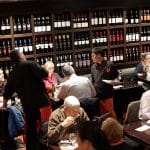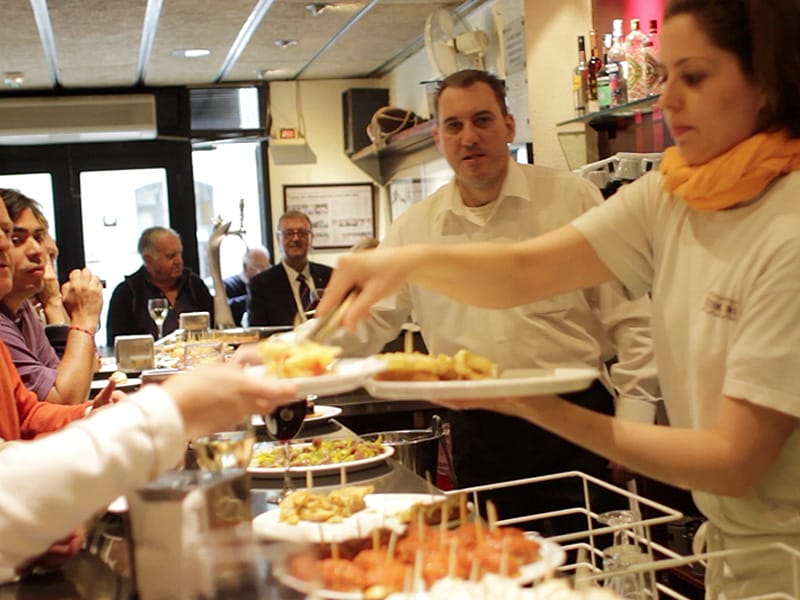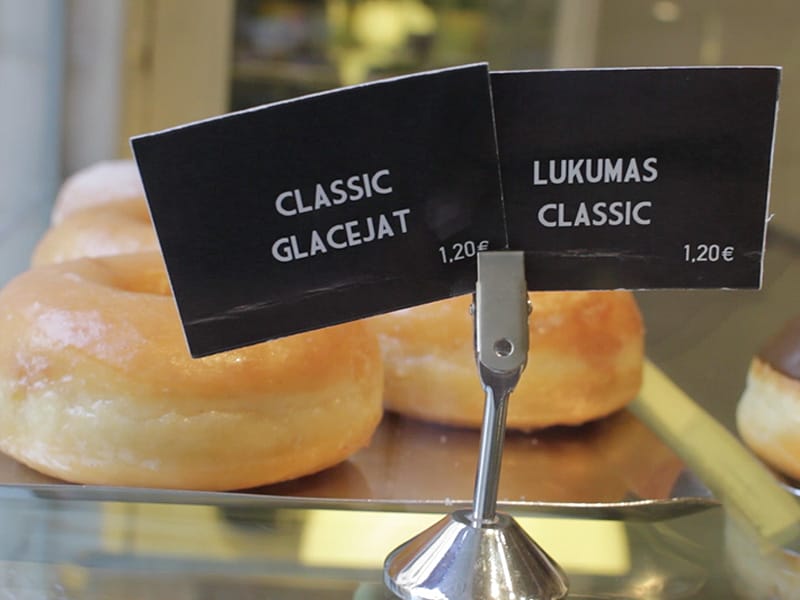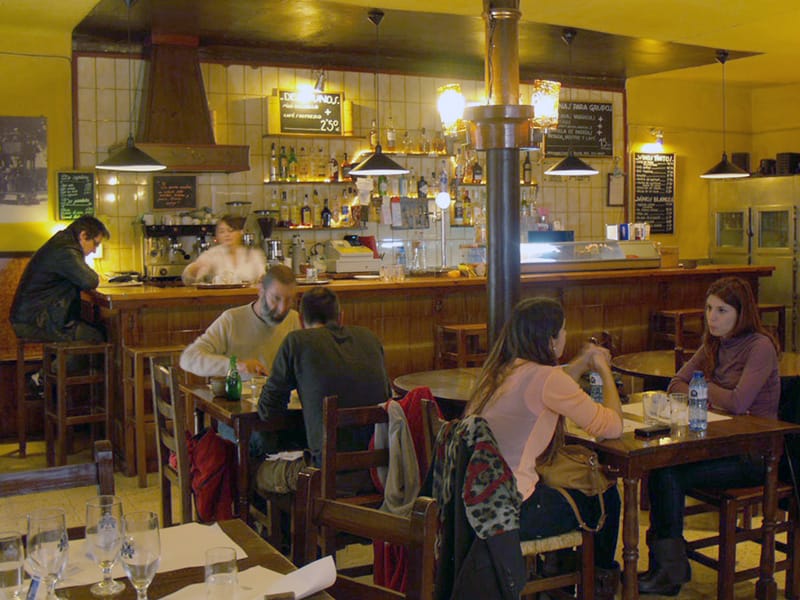When Julián Fernández and Carmen Erdocia moved to Barcelona in 1996, they bought an old fútbol salon in the Eixample that was named Táctica, or “tactics,” in a reference to Spanish football. Julián and Carmen began serving pintxos such as tortilla de bacalao (Spanish omelet with codfish) to hungry futboleros. Eventually, the venue became so popular that they decided to convert Táctica into a Basque restaurant specializing in pintxos. The name was easy: Taktika Berri means “new tactics” in Basque.
Hailing from San Sebastián – the pintxo capital of the world – the Fernández family lives gastronomy like a vocation because it is their vocation. Carmen, who is joined by three cooks, is the heart and soul of the kitchen. She learned to cook from her mother-in-law, Alejandra, who shared her family recipes until one day declaring Carmen a bona fide cocinera. Siblings María and Iker are convivial hosts who extend a warm, familial feeling to the front of house. Although retired, Julián can still be seen on any given night dining with friends or tending cash at the register.
Taktika Berri delights palates with tasty pintxos, and Basque patrons are a guarantee of the venue’s irrefutable authenticity. Pintxos are tapas affixed to a piece of bread with a toothpick – pintxo comes from the Spanish pinchar, to pierce. Tradition dictates that pintxos are presented open-air, on plates spanning the length of the bar. Patrons are handed a plate and are free to help themselves to whichever pintxos appeal to their whimsy or stomach. The strategy is to ogle the elaborately prepared, bite-sized creations resting on each plate and pounce when ready. Once you have finished, simply mosey up to the register and the camarero will count the number of toothpicks, or pintxos consumed, at €1.45 each. Although there probably lurk a few “cheaters,” it’s nice that the honor system seems to work.
A pintxo crawl is a fine start to an evening, so order a Txakoli and dive into the pintxos. Txakoli, a cloudy white Basque wine, is light and refreshing; it pairs well with anything from the ocean and also olives, surprisingly. The traditional way to pour Txakoli is with a high pour, creating something like a waterfall. The natural fizz of the wine plus the aeration created by pouring into the glass from arm’s length are what give this wine its unique character. One big miss on the drink front was the sidra (cider), which tasted flat and uninspired. We have sung praise for delicious Asturian sidra before, but this was totally forgettable.
With tumbler in hand, sidle up to the bar and try la gilda, the quintessential pintxo: anchovy, olive and guindilla pepper. Next, look for its cousin, featuring boquerones, roasted green pepper and egg, plus a dollop of mayonnaise, vinegar and herbs. The foie gras we tried was rich, buttery and smooth – in a word, excellent. Tortilla de bacalao was oily but tasted light; it was so popular, it flew off the plates. Morcilla (blood sausage), a thick, black sausage made of pig’s blood, rice, onions and spices, sounds gross, but it’s not. It was served with a smoky salsa with a note of chipotle, a perfect complement. Though not our favorite, xistorra, a spicy Catalan sausage made with paprika, is a safe option for carnivores. While nibbling on our last pintxo – a dreamy, good-as-it-gets croqueta that was on par with those made by our aunt Pepetas in Sevilla (whose are the best in the world) – we noticed that the mayo-laden pintxos were hanging out rather forlornly on the plates in large numbers. Keep your eyes peeled for the far more popular hot morsels, which tend to get snapped up as soon as they arrive from the kitchen.
The bar is as important if not more so than the comedor in the back, which serves more filling dishes. Some of the platos estrellas from the restaurant include tortilla de patatas / bacalao (Spanish potato / cod omelet), pochas (white beans), tronco / cogote de merluza (hake) and chuletón (chops). Reservations are required, so call in advance. Eating at the bar is permitted during the day, but at night, service is restricted to pintxos. Get here early because, from the second the door opens at 8:30 each evening, the bar teems with locals anxious to bite into the best Basque tapas in town.
Editor’s note: This review was originally published on August 20, 2012.
 December 27, 2012 Best Bites of 2012: Barcelona
December 27, 2012 Best Bites of 2012: Barcelona
Editor’s note: This is the penultimate installment of “Best Bites of 2012,” a roundup of […] Posted in Barcelona July 27, 2012 La Flauta
July 27, 2012 La Flauta
Catalan owners, Filipino chefs and a menu offering comfort food inspired by the cooking […] Posted in Barcelona January 2, 2015 Casa Pagès
January 2, 2015 Casa Pagès
Editor's note: We're wrapping up Soup Week here at Culinary Backstreets with an old […] Posted in Barcelona
Hollis DuncanHollis Duncan
Published on July 31, 2013
Related stories
December 27, 2012
Barcelona | By Johanna Bailey
BarcelonaEditor’s note: This is the penultimate installment of “Best Bites of 2012,” a roundup of our top culinary experiences over the last year. Stay tuned for our final “Best Bites” dispatch, from Istanbul, tomorrow. Restaurant Roma We hadn’t planned on bringing in La Nochevieja at Restaurant Roma, but it was nearby and we didn’t feel…
July 27, 2012
Barcelona | By Hollis Duncan
BarcelonaCatalan owners, Filipino chefs and a menu offering comfort food inspired by the cooking of Iberian sailors: La Flauta, a restaurant-cum-tapas-bar that goes long both on good taste and good value, is an excellent reminder of the benefits of Barcelona’s being a port town. Take, for example, Friday, when the menú del día features fideuà.…
January 2, 2015
BarcelonaEditor's note: We're wrapping up Soup Week here at Culinary Backstreets with an old favorite in Gràcia that serves classic wintertime Spanish soul food. Not far from the Gràcia neighborhood’s glittering Paseo de Gràcia can be found a completely different world of narrow, unassuming side streets. Once populated by Catalan Gypsies, the area is fondly remembered as…

















































































